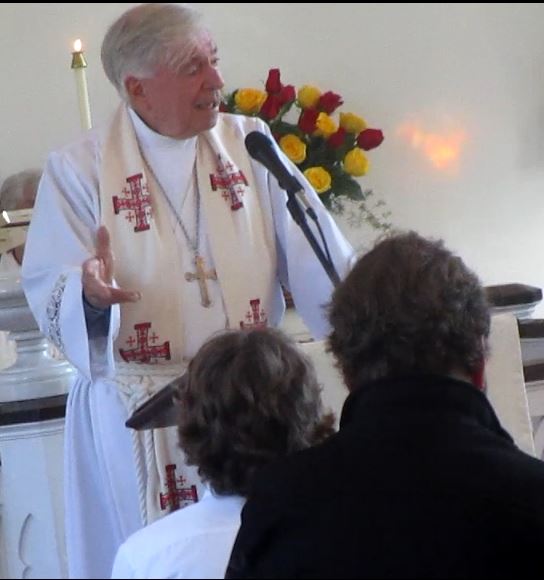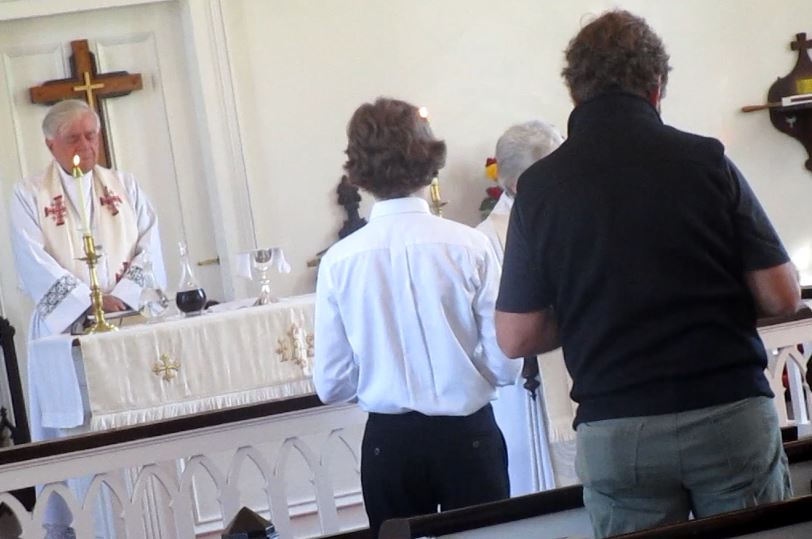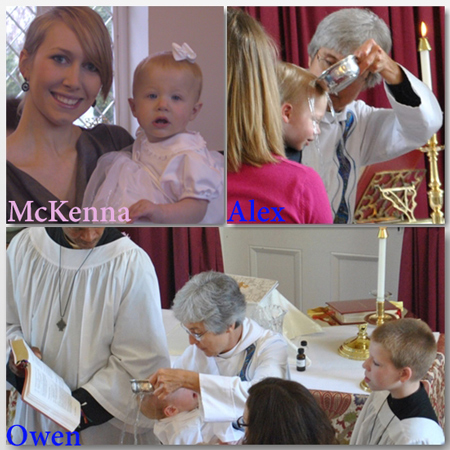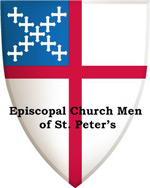Click here to view in a new window.
2023 Sun Nov 5
Sunday Links, Nov. 5, 2023
A feast Day- All Saints Sunday, Nov. 5, 2023
Lectionary link for Nov. 5, All Saints Sunday
Lector: Cookie Davis
Chalice Bearer: Johnny Davis
Altar Cleanup: BJ Anderson
Looking ahead…
Lectionary, Pentecost 23, Year A, All Saints
I.Theme – Experience of God’s salvation allows to consider life with the perspective of faith and to celebrate all the saints. The way of life should be based on the Gospel reading, the Beatitudes.

"Sermon on the Mount"– Henrik Olrik (1860) Denmark
The lectionary readings are here or individually:
First Reading – Revelation 7:9-17
Psalm – Psalm 34:1-10, 22 Page 627, BCP
Epistle –1 John 3:1-3
Gospel – Matthew 5:1-12
The readings this week provide guidelines how saints should live their lives – in the present based on the Beatitudes while mindful that life isn’t easy, persecution abounds but that we live in God’s presence and that the hope of salvation remains.
The larger context of Revelation 7:9-17 is the opening of the seven seals (Revelation 6:1-8:5), which describe apocalyptic catastrophes that will accompany the close of this age. Revelation 7 is often described as an interlude between the sixth (Revelation 6:12-17) and seventh (Revelation 8:1-5) seals.
The chapter separates between a description of the Church being persecuted at the close of the present age (vv. 1-8), and a picture of the Church in heaven in the new age after the saints have passed through the period of persecution (vv. 9-17). These portraits of the Church have been contrasted by past interpreters as the Church militant in the present age and the Church triumphant in the age to come. The lectionary lesson for All Saints Day is the latter half of chapter 7, the picture of the Church triumphant in the age
The passage presents a vision of God’s eternal presence which is both profoundly Christ-centered and universal in its scope. It consists of a conversation between “one of the elders” and John, the author of the Revelation, giving details of what John saw in his vision and why the vast multitude from every nation is to gather before the throne of God.
At the close of the age they were the ones who were persecuted (v. 14), and they now live in the eschatological age (vv. 15-17). The power of this text lies precisely in this discontinuity, for it states that our experience in this world cannot be a reliable indicator of the character of God or even of the quality of our salvation.
All Saints is a celebration of the same mysterious, sovereign power of God, for in commemorating the dead we are in fact celebrating life. This feast is in many ways an affront to our everyday experience, because in celebrating it, we share in John’s end-time vision
The good news of Revelation 7:9-17 was that God’s salvation is better than anything that we might experience in our everyday lives. The central metaphor used to convey this message was that God can make white from red, salvation from blood and persecution.
The Psalm is a response to the Revelation reading. The main purpose of the psalm is to celebrate with gratitude the saving power of Yahweh. It expresses great confidence and trust in Yahweh’s special care for the righteous.
Viewed from a wider perspective, the psalm points to the constant mercy and love with which Yahweh watched over and delivered Israel from innumerable disasters. At the same time it draws more attention to the individual believer who trusts in Yahweh than to the nation as a whole. This too has been the attitude of saintly Christians through many generations.
The psalm has been chosen for All Saints Sunday because of the reference to the "saints" in v. 9 (NRSV translates the Hebrew "you his holy ones"). The reference to the people of God as saints is unusual in the Old Testament, because this term usually refers to supernatural beings. This is probably the only reference where the people of God are identified as the saints.
The psalm is concerned with the experience of God’s salvation. The exploration of salvation is done in the first person in v. 4, when the psalmist recounts an experience of deliverance, and it is repeated in v. 8 when the other worshipers are encouraged to taste and to see that the Lord is good.
With a deep understanding of God’s ultimate purpose for the end of history, the Epistle of John attempts to describe just what we shall be like and how that will come about. He declares the simple faith that because God loves us and because we are the children of God, in the end we shall be like God. He spoke in spiritual terms, of course, which means that we shall be spiritual as God is Spirit.
The 1st Epistle of John contains many references to a congregation of Christians being under severe threat by a dissident group. These dissidents may have been either Greeks who rejected Jesus as a truly human person or Hebrews who rejected Jesus as the divine Messiah; or both. The epistle came from a time near the end of the 1st century CE, when those who believed in Jesus Christ and followed the Christian way had to be both clear about their faith and strong in their commitment.
Because of the challenges they encountered every day from both imperial authorities and public hostility, they could never know when their faith would bring them face to face with death.
The dissident members of their own congregation proclaimed a false teaching which sought to undermine the true understanding of the person and redemptive work of Christ. The dissidents broadcast far and wide that Jesus was not the Christ and therefore could not be the Saviour. How was it possible for them to maintain their commitment under such circumstances?
They could be certain of only one thing: that they were loved by God; they were God’s holy children. A life rooted and grounded in love would bring them to the only worthwhile end. Whatever fate might bring upon them, and in particular rejection or even martyrdom for their faithfulness, they were constantly reassured that they would not only be with God, but would be like God.
The Gospel reading is Matthew’s account of the Beatitudes. The Beatitudes set forth how Jesus saw those who are to inherit the reign of God’s gracious, redemptive love. While this description may seem to project beyond current reality into a far distant future, it also set forth a value system on the basis of which we can live from day to day because that reign of God has already begun. This is the way of life lived by the saints now and eternally.
The Sermon on the Mount in Matthew 5-7 is a collection of sayings Jesus may have uttered at different times and places, rather than delivered all at once in a single discourse. These have been influential over time. Dr. King often pointed out that it was Jesus’ Sermon on the Mount that inspired the "dignified social action" of the civil rights movement. His notion of "creative suffering" – borne by civil rights activists who endured persecution and police brutality – came from his Christian faith in the redemptive suffering of Jesus.
The Beatitudes summarize the revolutionary values intended to guide those seeking to follow Jesus. Each one is a sermon in itself, and the whole passage has generated many a sermon series from pulpits of yesteryear. Those who would have a little variation from the lectionary would do well to select this passage for such a continuum.
Beatitudes appear in the OT according to a single pattern beginning with the Hebrew word for blessed or happy) after which they usually described someone worthy of praise. Matthew quoted Jesus using the same method and adding the reason for this happy state.
The main difference from OT beatitudes, however, is their stress on eschatological joy of sharing in the reign of God as opposed to receiving rewards for living righteously here and now. The reign of God comes, the beatitudes insist, not by implementing human schemes of moral and social improvement, but by the gracious gift of God.
Another feature to be noted is the paradoxical quality of the Matthean beatitudes. They contradict the normal expectations of ordinary people and their reactions to human experience. The people Matthew identifies are not supposed to be happy – the poor, the mourners, the persecuted. Many martyred witnesses to the faith went to their death believing that a vastly better life awaited them in the heavenly realm.
Yet the message of the Matthean beatitudes is not exclusively for a distant future. Rather, it is for the present. The words were spoken to generate trust in God in difficult circumstances, not simply to enable us to endure hard times.
The beatitudes define the way that Jesus himself lived to the point of death as a rejected religious revolutionary and unjustly condemned criminal. Such spiritual power comes not through our most noble human efforts, but through the gift of grace the Spirit gives us.
Visual Lectionary Vanderbilt All Saints Day, Nov. 5, 2023
Click here to view in a new window.
Recent Articles, Nov. 5, 2023
Bulletin
Lectionary for All Saints
Commentary Nov. 5
Vanderbilt visual commentary
The Gospel – The Beatitudes
Stewardship Commentary
End of October early Nov.
Summary
Reformation Day Oct. 31, 2023
Halloween, Oct. 31
All Saints Day, Nov. 1
All Souls Day, Nov. 2
Veterans Day, Nov. 11
Other links for All Saints
All Saints for Children
All Saints baptisms
Teaching All Saints
Ministries
The Village Harvest, Oct. 2023, the end of 9 years
ECM Thanksgiving donations
Completion of God’s Garden class
Stewardship 2024
To be a Church Rooted in Love
Planning your financial giving
Options for estimating your giving
Ministry Connections
About Stewardship
5 Principles of Stewardship
Stewardship is…
Stewardship FAQ
2024 Planning
Walk in Love planning help
Fall photos
Robert Frost, October
Early Fall
Autumnal Tints
Rev. Tom Hughes Sermon Summary, All Saints, Nov. 5, 2023

We are not yet what we shall be. That’s one of Tom’s favorite Bible phrase
“Beloved, we are God’s children now; what we will be has not yet been revealed.”
1 John 3:2
What happens along the way when you are transformed and you become saintly? You are set apart by God. To be transformed in God, you are beyond the law and beyond history. You are unique from any other creature from anyone who has ever been.
That’s what we want to be though we can be side-tracked. We don’t live by the standards of other people but live by what we learn from God.
To be this complete person we have to be honest with ourselves and God, open and without self-deception and that’s why we confess our sins. We need to be free of those things.
We are not controlled by things of this earth. To have our direction of how we live in this world come from God. That’s what sets us apart. What we want to be is genuine, not fake open with ourselves and God.
You are blessed if you adhere to the Beatitudes
We need to open ourselves to God in our lives and let God take the wheel The extent in which we do that is how real or genuine we are. The light of God is shining through them.
Who are these people robed in white? They are robed in the Holy Spirit. We know that is what we should be
The vision is that we are in that parade right now. We know what we shall be, the very creature God meant for us to be. This is the best outcome on the time on this earth and for eternity.
“Tens” Stewardship Commentary, Nov. 5, 2023
Click here to view in a new window.
Newsletter, November, 2023
Click here to view in a new window.
Prayers of the People, All Saints, 2023

The Prayers of the People
We give you thanks for those we have known and loved in this lifetime who rejoice with us, but upon another shore and in a greater light, that multitude which no one can number, and with whom, in your son Jesus Christ, we are one.
James Abourezk, (friend of Linda Kramer), John Anderson (brother of Jim Anderson), Susan Allen (friend of Linda Kramer), Bethune Andrews (sister of Linneth Feliciano), Ruby Barnes (sister of Laura Carey), Mattie Beale (friend of Mary Peterman and Denise Gregory), Easton Buchanan (cousin of Andrea Pogue), John Thomas Carter (Barbara Wisdom’s stepfather), Roger Chartters (friend of the Segars), Pansy Cohen (relative of Andrea Pogue) , Herb Collins (friend of Cookie Davis and Port Royal), David Fannon, David Fitzgerald (son of Lydia O’Neil), Lynn Garrett, Edward Geraci, (brother of Marion Mahoney), Louise Gossett (friend of Catherine Hicks) , Taylor Hayden (member of Scout Troop 304), Joan Johnson (Andrea Pogue’s family) , Billy Long (Larry Saylor’s brother-in- law) Bill McKnight (Chris Fisher’s uncle) , Nancy Newton Nolen (friend of Barabara Segar), Beverly Pauken (Mary Peterman’s sister), Sandra Smith, John Stoddard (friend of the Upshaws), Paris Swisher ( friend of Tom and Alice Hughes), Edith Taylor (friend of Cookie Davis), John Vartonklan, MD., Robert Walker, Jane Harrington Webber (Linda Kramer’s aunt), Jeremiah Williams
Tolling of the Bell
“We Remember Them”- Sylvan Kamens & Rabbi Jack Riemer
At the rising of the sun and at its going down; We remember them.
At the blowing of the wind and in the chill of winter; We remember them.
At the opening of the buds and in the rebirth of spring; We remember them.
At the blueness of the skies and in the warmth of summer; We remember them.
At the rustling of the leaves and in the beauty of the autumn; We remember them.
At the beginning of the year and when it ends; We remember them.
When we are weary and in need of strength; We remember them.
When we are lost and sick at heart; We remember them.
When we have decisions that are difficult to make; We remember them.
When we have joy we long to share; We remember them.
When we have achievements that are based on theirs; We remember them.
For as long as we live, they too will live, for they are now a part of us as, we remember them.
Loving God, you have bound us together in one communion and fellowship. Grant to us, your whole Church in heaven and on earth, your light and your peace as we continue on in our pilgrimage in faith with one another and with Jesus, our companion and friend. Amen.
And now, let us pray for an end to all violence and for the desire to walk the way of Jesus, for if only we follow that path, we will find God’s reign of love here, on this earth.
Lord, make us instruments of your peace. Where there is hatred, let us sow love; where there is injury, pardon; where there is discord, union; where there is doubt, faith; where there is despair, hope; where there is darkness, light; where there is sadness, joy. Grant that we may not so much seek to be consoled as to console; to be understood as to understand; to be loved as to love. For it is in giving that we receive; it is in pardoning that we are pardoned; and it is in dying that we are born to eternal life. Amen.
All Saints Sunday – A Time of Baptism

- McKenna Long – Jan. 2, 2011
- Alexander Long VI – Nov. 4, 2012
- Owen Long – Aug. 4, 2013
Baptism of Scarlett Joy Long is on Nov. 1, 2015. Congratulations! Baptism is one of the sacraments of the Episcopal Church and is one of the times of the year appointed for baptism.
Here are the 3 Whys of Baptism
ECM Community Thanksgiving donation

From Ken Pogue. “Each year the Episcopal Church Men help St Peter’s provide support to those in need during the holidays. The men coordinate with the Caroline County Department of Social Services to provide families in the area with gift cards
“Your donations are greatly appreciated by the ECM and the recipients of the gifts in the Port Royal community, Thank you so very much in advance from a grateful community.”
If you’d like to donate for the Thanksgiving offering, please make a check to St Peter’s with ECM in the memo line by Sunday, Nov. 5
Last year $500 was given at Thanksgiving and $750 Christmas.
